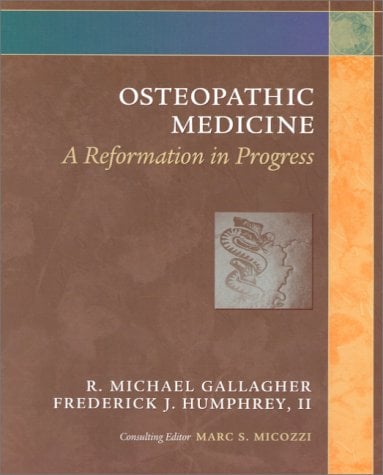Osteopathic Medicine: A Reformation in Progress
Source: Book description taken from Amazon.com Review
 by R. Michael Gallagher (Editor), Frederick J. Humphrey, Marc S. Micozzi (Editor)
by R. Michael Gallagher (Editor), Frederick J. Humphrey, Marc S. Micozzi (Editor)Book Description
Osteopathic medicine is a holistic method of health care that focuses on manipulative treatments to maintain the harmonious balance of the body's interactions. Osteopathic Medicine: A Reformation in Progress offers a broad-based introduction to the basic tenets of osteopathic medicine, from the roots of osteopathic reformation to its present and future role in primary care medicine. It addresses the problems that the osteopathic profession has faced and continues to face, and offers concrete and proactive recommendations for the future. Both osteopathic practitioners and physicians who practice mainstream medicine can benefit from the theories and practices presented in this intriguing text.
Osteopathic Medicine: A Reformation in Progress
is a long overdue reference for those seeking accurate information about the history and development of the ostoepathic medical profession. It concisely reviews the historical foundations and evolution of osteopathic medicine from a frontier-based medical sect to a full-fledged social movement in American health care.
In a well-written and engaging style, the authors provide the reader with a critical appraisal of where the osteopathic medical profession has been, its past achievements and current challenges, as well as a clear course for its future development. It also explores the dimensions of osteopathic medical education and practice that distinguish DOs from their MD counterparts. The authors review the philosophical foundations that drive the unique osteopathic approach to patient care as well as a critical appraisal of efforts to incorporate osteopathic principles and practice into the broader infrastructure and science of total health care management. This is book is highly recommended reading for all pre-medical students considering a career in osteopathic medicine, current osteopathic medical students and residents, as well as practicing physicians, and interested lay people. This book will also be of particular interest to medical educators and public health policy-makers who work to further refine and develop a health care system that is compassionate, accessible, evidence-based, integrative, and technologically advanced.
For all those who still quite do not understand what D.O.s contribute to the American healthcare system, this book is a perfect pick to read!
Here is an article from JAOA:
This insightful, user-friendly manual approaches the story of osteopathic medicine from past, present, and future perspectives. Osteopathic medical educators recount the history and purpose of osteopathic medicine in a book designed for physicians, student physicians, and interested nonphysicians.
Gerald G. Osborn, MD, MPhil, succinctly presents the complex history of osteopathic medicine, making it clear that this form of healthcare is a uniquely American phenomenon. Starting from humble beginnings, the osteopathic medical profession expanded its curriculum beyond that of the musculoskeletal system, yet purposely maintained a central theme that recognizes the importance of this system for the maintenance of health. Organizational cohesiveness, political and legal savvy, and certainly some good fortune allowed osteopathic medicine to not only survive, but to also develop a strong position in modern healthcare.
In chapter 2, John M. Jones, DO, focuses on osteopathic medicine as we know it today, exploring the osteopathic medical philosophy and how it has evolved. Later in the chapter, the osteopathic profession's "second great osteopathic philosopher," Irvin M. Korr, PhD, builds on the initial teachings of osteopathic medicine's founder, Andrew Taylor Still, MD, DO. The author reviews osteopathic principles and practice and uses case presentations to clarify these concepts.
Next, Barbara Ross-Lee, DO, describes how classic osteopathic medical care evolved into a healthcare delivery profession with a primary care emphasis. As allopathic medicine pursued specialty and subspecialty care, osteopathic medicine maintained its focus and strength in primary care medicine.
Felix J. Rogers, DO, explains in another chapter how, despite this primary care focus, specialty and subspecialty care evolved within the osteopathic medical profession. The evolution of these areas of specialization accelerated the profession's prestige and increased its acceptance by patients. Osteopathic physicians chose to maintain the basic practices of osteopathic medicine, however, and implemented osteopathic medical tenets, which were later expanded.
Douglas L. Wood, DO, discusses the progressiveness of the osteopathic medical education process, the growth of which was necessary to support the growth that was occurring in the profession. Dr Wood's explanation helps readers to understand how the basic tenets of osteopathic medicine were maintained as the profession matured and was integrated into the healthcare environment.
The final chapter focuses on the future of osteopathic medicine. Here, the editors, R. Michael Gallagher, DO; Frederick J. Humphrey II, DO; and Marc S. Micozzi, MD, PhD, speculate how the osteopathic medical profession may change over time, noting in particular the ways in which patient care and medical education need to change so that osteopathic medicine remains separate from allopathic medicine as a healthcare system.
I recommend this book for experienced osteopathic physicians as well as osteopathic physicians-in-training and individuals who are interested in understanding the osteopathic medical profession.
I have now read this book twice and, with each reading, have learned a great deal. I have a greater appreciation for the foundation of hard work that was required to develop this professional opportunity that allows osteopathic physicians to provide patients with a distinct and effective mode of therapy.
0 Comments:
Post a Comment
<< Home